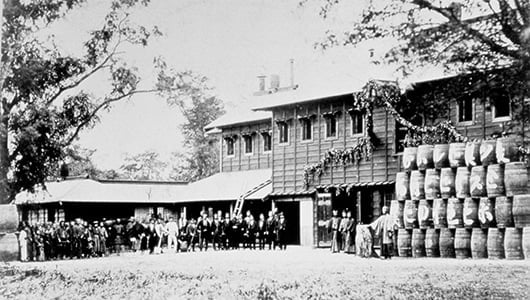The Origins of Sapporo Beer
The story of Sapporo Beer begins in the late 19th century, during a period of rapid modernization in Japan. Founded in 1876, the Sapporo Brewery was established in Hokkaido, a region that the Japanese government was actively developing at the time. The founder, Seibei Nakagawa, was Japan’s first German-trained brewmaster, and he brought with him the sophisticated techniques and deep knowledge necessary to produce beer that adhered to the high standards of European breweries.
The early years of the brewery were marked by experimentation and innovation as Nakagawa adapted German brewing methods to local conditions—using Hokkaido’s fresh water, high-quality barley, and the distinctive climate to craft a unique beer. This adaptation process was crucial as it laid the foundation for a beer that was not only refreshing but also resonated with the local palate, helping to establish Sapporo as a leading name in the Japanese brewing industry.
The brewery’s location in Hokkaido also played a significant role in its development. The region’s cold climate was ideal for lagering—the process of cold storing beer—which is a critical phase in the production of lagers like those produced by Sapporo. This geographical advantage allowed the brewery to perfect its lagering process, leading to the distinctive taste and quality for which Sapporo is known today.
The Evolution of Sapporo Beer
Over the decades, Sapporo Beer has evolved significantly, adapting to changes in consumer tastes and advances in brewing technology. In the early 20th century, Sapporo began to expand its product range, introducing various styles that catered to the diversifying tastes of its customers. This period saw the introduction of darker beers and the experimentation with different hop varieties, each contributing to a broader flavor profile that appealed to a wider audience.
The post-war era was particularly transformative for the brewery as it merged with several other Japanese breweries to form the Nippon Beer Company, which later reverted to the Sapporo name. These mergers were strategic, enabling Sapporo to leverage collective resources, research, and distribution networks to strengthen its presence in the market. As a result, Sapporo became not just a beer for the local Japanese market but an international brand that beer enthusiasts around the world recognize and appreciate.
Technological innovations also played a crucial role in Sapporo’s evolution. The adoption of automated brewing systems in the mid-20th century allowed for greater consistency and efficiency in production. These technological advancements ensured that each bottle of Sapporo Beer maintained the same high quality, regardless of where it was brewed and consumed.
Unique Flavors of Sapporo Beer
The flavor profile of Sapporiginates from its careful selection of ingredients and the precision of its brewing process. Sapporo beers are generally characterized by their clean, crisp taste which comes from the special blend of hops used. These hops not only impart a mild bitterness but also a subtle floral aroma that distinguishes Sapporo from other beers.
Sapporo Premium Beer, one of the flagship products, is a perfect example of this. It is brewed with a balanced mix of bitter and aromatic hops that gives it a smooth, refreshing taste that is versatile enough to pair well with a wide range of foods—from Japanese sushi to Western burgers. This versatility has helped Sapporo Premium Beer gain favour among a diverse group of beer drinkers.
Another popular variant, the Sapporo Black, showcases the depth that Sapporo can offer. This dark lager features roasted malts that provide a rich, coffee-like flavor, complemented by a slight sweetness. This complex flavor profile makes Sapporo Black a favorite among those who appreciate robust, full-bodied beers.
The Global Reach of Sapporo Beer
Today, Sapporo Beer enjoys a presence on the global stage, exported to numerous countries and enjoyed by millions of beer lovers worldwide. This international success is a testament to Sapporo’s enduring appeal and its ability to adapt to global tastes while maintaining the high quality and unique flavor profile that it is known for.
The brand has also made strategic partnerships and acquisitions, such as the purchase of the Canadian brewery Sleeman, to further expand its international footprint. These moves not only help Sapporo reach new markets but also allow it to explore new brewing techniques and ingredients, further enhancing its product offerings.
The global appeal of Sapporo is also bolstered by its active participation in international beer festivals and competitions, where it has received numerous awards and accolades. These recognitions serve to reinforce Sapporo’s position as a world-class beer manufacturer.
A Cultural Icon
Beyond its flavor and global reach, Sapporo Beer has become a cultural icon, associated with the rich heritage and modern dynamism of Japan. Its distinctive silver can, featuring the Star of Sapporo, is recognized worldwide and symbolizes quality and craftsmanship.
The brand has also been a part of various cultural initiatives and events, promoting not just the beer, but also the art, music, and film of Japan, thereby enriching its cultural significance. Such activities not only enhance the brand’s image but also create a deeper connection with consumers by engaging with them on multiple levels beyond just the taste of beer.
In conclusion, the journey of Sapporo Beer from a local Japanese brewery to a global beer icon is a remarkable story of innovation, adaptation, and persistence. It is a brand that has not only stood the test of time but has also managed to captivate the hearts of beer lovers around the world, making it a true ambassador of Japanese brewing culture.
